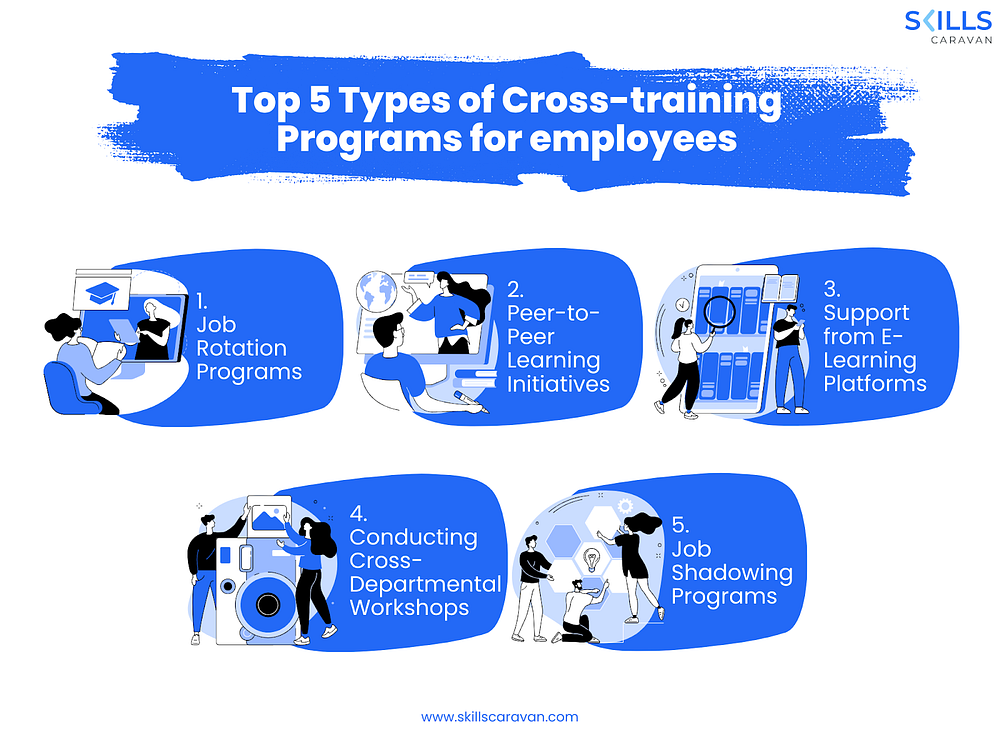Cross Training Employees: Examples That Every L&D Manager Should Try
In today’s fast-paced, unpredictable business environment, agility is not a luxury — it’s a necessity. One powerful way to build this agility into your workforce is through cross training employees. By equipping team members with skills beyond their primary roles, organizations can enhance productivity, ensure continuity during absences, and boost employee engagement.
For Learning & Development (L&D) managers, cross training is not just a tool — it’s a strategic advantage. Let’s explore what cross training employees really means, and walk through practical examples every L&D professional can implement.

What is Cross Training?
Cross training employees involves training workers to perform tasks outside their usual job responsibilities. This doesn’t mean turning a marketing specialist into a full-time accountant, but rather helping them understand and handle basic finance tasks if needed. The goal is to build a multi-skilled team that can adapt and respond quickly to shifting business needs.
Benefits of Cross Training Employees
Before diving into examples, it’s essential to understand the core benefits of cross training employees:
- Increased flexibility: Employees can fill in for absent coworkers, reducing workflow interruptions.
- Improved collaboration: Cross-functional understanding boosts team communication and problem-solving.
- Enhanced employee engagement: Learning new skills keeps employees motivated and invested.
- Better talent utilization: You unlock hidden potential by allowing employees to contribute in new ways.
- Stronger succession planning: It becomes easier to promote internally when employees understand multiple roles.
7 Real-World Examples of Cross Training Employees
Let’s look at actionable ways to implement cross training employees in various departments and industries:
1. Job Shadowing Across Teams
Example: A customer support executive spends one day a week shadowing the sales team.
Why It Works: This provides insight into the customer acquisition process, allowing support teams to align their communication with customer expectations better. It also helps sales teams understand recurring support issues, leading to improved service delivery.
2. Rotational Programs
Example: New hires in a tech company rotate through QA, development, and product management during their first three months.
Why It Works: This broad understanding of the product lifecycle builds empathy and cross-functional knowledge, essential for long-term collaboration and innovation.
3. Departmental Workshops
Example: The finance department holds monthly knowledge-sharing workshops attended by operations, HR, and admin teams.
Why It Works: These sessions help non-finance staff understand budgeting, compliance, and forecasting, reducing bottlenecks in approvals and planning.
4. Reverse Mentoring for Digital Skills
Example: Younger employees train senior staff on tools like Slack, Canva, or AI productivity apps.
Why It Works: While not traditional in structure, this form of cross training employees boosts digital fluency across the organization while empowering junior staff.
5. Buddy Systems for Seasonal Workloads
Example: In retail or hospitality, front desk staff are trained to assist in inventory or food preparation during peak seasons.
Why It Works: When demands spike, having employees who can jump into different roles reduces the pressure on any single team and improves service quality.
6. Cross-Training in Safety Protocols
Example: In manufacturing units, machine operators are trained in basic safety compliance, fire drills, and first aid.
Why It Works: This creates a safer work environment and builds confidence in handling emergencies. It’s a mandatory and highly practical form of cross training.
7. Project-Based Cross Functional Teams
Example: An internal project to improve the onboarding experience includes members from HR, IT, admin, and training teams.
Why It Works: Team members learn how other departments function, fostering collaboration and a more holistic understanding of company operations.
How to Implement a Cross Training Strategy
As an L&D manager, rolling out a cross training employees program requires careful planning. Here are the steps to get started:
- Assess Training Needs: Identify key roles that are vulnerable or in high demand. Focus on tasks that are transferable and useful to others.
- Get Manager Buy-In: Team leaders must support the idea of employees temporarily stepping away from their core roles.
- Start Small: Pilot the program with a few departments. Track results and scale based on feedback.
- Track Progress: Use skills matrices or digital tools to track who has been cross-trained and in what areas.
- Recognize and Reward: Acknowledge the effort employees put into learning new roles — consider incentives or certifications.
- Document the Process: Create SOPs or quick reference guides for the tasks being taught, ensuring consistency across trainees.
Challenges and How to Overcome Them
While the benefits are clear, cross training employees can come with hurdles:
- Time Constraints: Cross training takes people away from their main duties. Solution: integrate learning into less busy periods.
- Resistance to Change: Some employees may feel threatened. Solution: Emphasize career growth and job security.
- Lack of Resources: Not all companies have formal L&D teams. Solution: Use peer learning and informal mentoring to get started.
Tools to Support Cross Training Employees
Modern L&D teams can leverage several tools to support cross training employees:
- LMS (Learning Management Systems): Platforms like Moodle, TalentLMS, or Docebo help track training paths.
- Knowledge Sharing Apps: Tools like Notion, Confluence, or Slite can be used to document cross-functional processes.
- Skill Matrix Templates: Help visualize skill gaps and coverage across teams.
- 360-Degree Feedback: Gather input from across departments to assess training impact.
Final Thoughts
Cross training employees is no longer optional in a fast-moving, collaborative work environment. For L&D managers, it’s an invaluable tool for unlocking talent, driving engagement, and ensuring operational continuity. With the right strategy, tools, and leadership support, you can build a team that’s not just well-trained — but future-ready.

Comments
Post a Comment